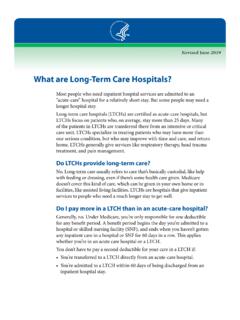Transcription of CMS Operational Guidance for Acute Care Hospitals to ...
1 1 Operational Guidance for Acute care Hospitals to Report Central Line-Associated Bloodstream Infection (CLABSI) Data to CDC s NHSN for the Purpose of Fulfilling CMS s hospital Inpatient Quality Reporting (IQR) Requirements Updated November 2019 The Centers for Medicare and Medicaid Services (CMS) published final rules in the Federal Register on August 16, 2010 and August 19, 2013 that include central line-associated bloodstream infection (CLABSI) reporting from Acute care Hospitals via the Centers for Disease Control and Prevention s (CDC s) National Healthcare Safety Network (NHSN) in the CMS hospital Inpatient Quality Reporting (IQR) Program requirements. More specifically, the rules announced reporting requirements for CLABSI data from Acute care Hospitals that began on January 1, 2011 were expanded on January 1, 2015. This Operational Guidance provides additional information about reporting CLABSIs to NHSN as part of the hospital IQR Program.
2 The requirements for CLABSI reporting to NHSN for this CMS program do not preempt or supersede any state mandates for CLABSI reporting to NHSN (specifically, Hospitals in states with a CLABSI reporting mandate must abide by their state s requirements, even if they are more extensive than the requirements for this CMS program). NHSN users reporting CLABSI data to the system must adhere to the definitions and reporting requirements for CLABSIs as specified in the NHSN Patient Safety Component Protocol at This includes reporting of denominator data (patient days and central line days), as well as CLABSIs, which are defined as primary bloodstream infections, specifically, not secondary to an infection at another body site, that are laboratory-confirmed and occur when a central line or umbilical catheter is in place for >2 calendar days and still in place on the date of the event or the day before (with the day of device placement being day 1), from each patient care location in which facilities are required to monitor and report CLABSIs.
3 Acute care Hospitals must report CLABSIs and associated denominator data for infections that occur on or after January 1, 2015 from all adult, pediatric, and neonatal intensive care units 2 (ICUs) and from all patient care locations meeting the NHSN definition for adult and pediatric medical, surgical, or combined medical/surgical wards. Unless a hospital submits a hospital IQR Program Healthcare Associated Infection (HAI) Exception Form (available through QualityNet) to indicate that they have no adult, pediatric, or neonatal ICU locations and no adult or pediatric medical, surgical, or combined medical/surgical wards (in accordance with NHSN location definitions), monthly reporting plans must be created or updated in NHSN to include CLABSI surveillance in all locations from which reporting is required, specifically, CLABSI surveillance must be in the monthly reporting plans ( in-plan ) in order for data to be shared with CMS.
4 All data fields required for both numerator and denominator data collection must be submitted to NHSN, including the no events field for any month during which no CLABSI events were identified in each patient care location under surveillance. Data must be reported to NHSN by means of manual data entry into the NHSN web-based application or via file imports using the Clinical Document Architecture (CDA) file format for numerator and denominator data (resources available at ). CDC/NHSN requires that data be submitted on a monthly basis and strongly encourages healthcare facilities to enter each month s data within 30 days of the end of the month in which it is collected (for example, all March data should be entered by April 30) so it has the greatest impact on infection prevention activities. However, for purposes of fulfilling CMS quality measurement reporting requirements, each facility s data must be entered into NHSN no later than 4 months after the end of the reporting quarter.
5 In other words, Q1 (January/February/March) data must be entered into NHSN by August 15, Q2 must be entered by November 15, Q3 must be entered by February 15, and Q4 must be entered by May 15 for data to be shared with CMS. CLABSI data submitted to NHSN by Hospitals that have completed their Annual Payment Update (APU) pledges will be reported by CDC to CMS for each hospital . CDC will share all in-plan CLABSI data from locations that are required to report CLABSIs (adult, pediatric, and neonatal 3 ICUs and adult and pediatric medical, surgical, or combined medical/surgical wards for Acute care Hospitals ). CDC will provide hospital -specific CLABSI standardized infection ratios (SIR) for each reporting hospital by CMS Certification Number (CCN). CLABSI SIRs calculated using the 2015 NHSN baseline will exclude mucosal barrier injury (MBI) events from the numerator.














